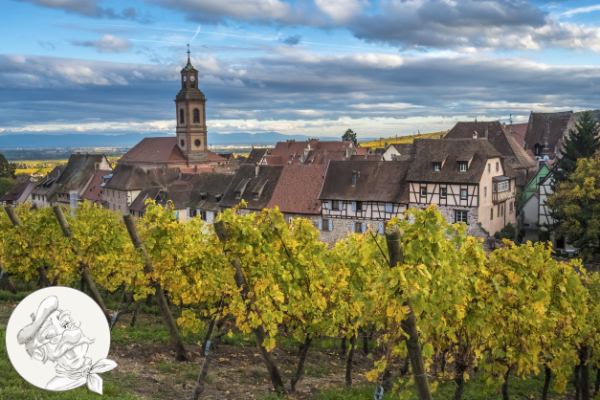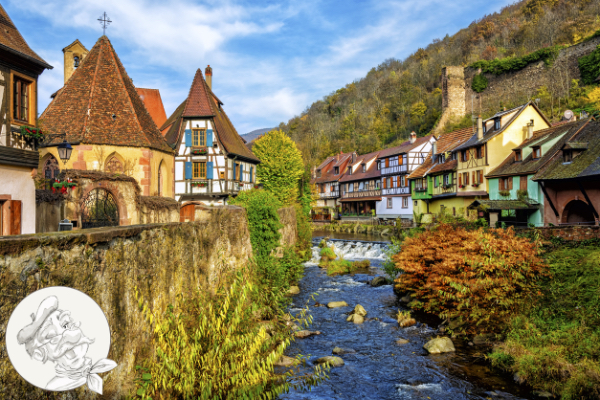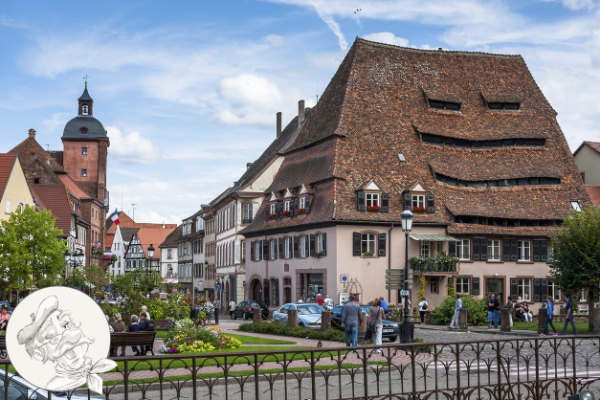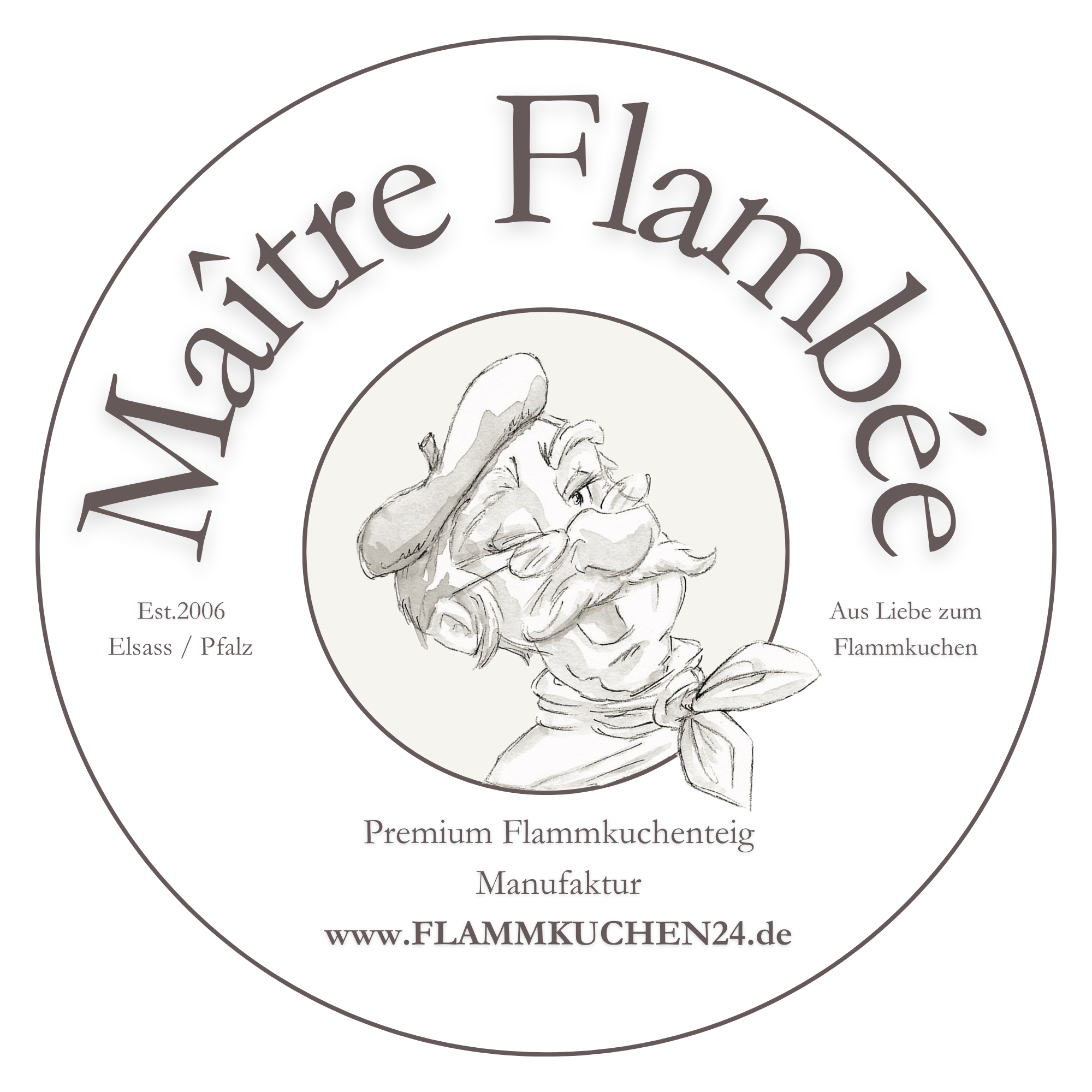Impressions from Alsace - The birthplace of the "Original Alsatian Tarte Flambée" dough

The tarte flambée - birthplace of the original Alsatian tarte flambée dough / tarte flambée base
The special thing about the Tarte Flambée or Flammkueche, as it is also often called in Alsace, besides its particular taste, is the tradition that gave rise to it: namely, it dates back to a time well over 100 years ago, when on the Alsatian farms of Kochersberg the bread was still baked in the in-house wood-burning oven. After the oven wood was lit, it was necessary to check when the oven had reached the right temperature for the bread. Therefore, the farmers separated a small piece of the dough, rolled it out thinly and placed it on the hot stone plate in the oven for a few minutes - into the flames. If the piece of dough became nice and crispy, the temperature was perfect for the bread. One day, one of the farmers - an ancestor of mine, by the way - had the idea to put his favorite ingredients, bacon and onions, on the dough patties before putting them in the oven. Underneath he spread some cream. The smell that came out of the oven attracted the farmers from the neighborhood, so my ancestor divided the pancake into several pieces so that everyone could taste some. The result was so delicious that it became a tradition and, over the years, a delicacy - the "Original Alsatian Tarte Flambée".





THEN: The "CHATEAU LANGENBERG" in Wissembourg/Alsace - birthplace of the tarte flambée in gastronomy - La "Tarte Flambée"!
In my youthful days, original Alsatian tarte flambée was served in the basement of Château Langenberg near Wissembourg - the conviviality in this basement attracted a whole host of happy people from all generations - a point of attraction for the original Alsatian tarte flambée without equal. The atmosphere in this cellar tavern was unique, today such an exuberant atmosphere can hardly be experienced today...
People sat together and talked. Talked about God and the world, also about the dog at the neighboring table, which had lifted its leg at the bench outside shortly before, or about other world-shaking matters. On one side of the cellar room were baskets with the dough, which was rolled out, topped and pushed into the wood-burning ovens as a "tarte flambée".
Sometimes there was green salad with garlic with the tarte flambée - sometimes not. There was always Côtes du Rhône, always plenty. But we couldn't always afford it - there was also open rouge in the carafe, which was good, most of the time, and cheap and also had its effect.
This included playing the guitar sometimes in the early evening. It was always loud. It was also loud because of the discussions with great implications, sometimes fierce - but always conciliatory in the end. Tolerant people drank and ate for hours in this basement. People sat at long, dark wooden tables. On the tables were wooden boards on which the tarte flambée was cut. The tarte flambée was not ordered, but the waiter let it slide again and again freshly baked on the boards. For each tarte flambée there was a chalk line on the table. Everyone at the table angling for a piece.
The animated conversation did not have to be interrupted orders at the waiter, they came freshly baked actually until the sink. Somehow, eating tarte flambée at the Langenberg was always completely decelerated, carefree, simple, casual - and usually pretty fun.
ALSACE
Alsace is a historic region in eastern France, known for its rich culture, stunning landscapes and excellent cuisine. Here is some important information about Alsace:
- Location: Alsace is located in the northeast of France, bordering the Rhine to the west and the Black Forest to the east. It also shares a border with Germany to the north.
- Capital: The capital of Alsace is Strasbourg, a fascinating city with a rich history and a charming old town. Strasbourg is also the seat of the European Parliament.
- Language: The most spoken language in Alsace is Alsatian, an Alemannic dialect. However, French is the official language.
- Culture: Alsace has a unique cultural blend of French and German influences. This is evident in the architecture, cuisine and traditions of the region.
- Viticulture: Alsace is known for its excellent wines, especially the white grape varieties such as Riesling, Gewürztraminer and Pinot Gris. The picturesque wine route (Route des Vins) attracts many visitors every year.
- Gastronomy: Alsatian cuisine is famous for dishes such as tarte flambée, sauerkraut, baeckeoffe (a type of stew) and Munster cheese. These hearty dishes are often accompanied by a glass of Riesling.
- Nature: Alsace offers stunning scenery ranging from rolling hills and vineyards to dense forests and picturesque villages. The Ballon d'Alsace is the highest peak in the region and offers spectacular views.
- History: Alsace has a complex and eventful history, having passed back and forth between France and Germany over the centuries. This has contributed to the cultural diversity and the preservation of a unique identity.
- Tourism: Alsace is a popular destination for tourists who want to explore the charming villages, historic towns and beautiful nature. Visitors can also experience the famous wine festivals and markets that take place throughout the year.
- European institutions: In addition to Strasbourg as the seat of the European Parliament, Alsace has also been home to the Council of Europe and the European Court of Human Rights. This has made Alsace an important hub for European politics and law.
Alsace is undoubtedly a fascinating region that offers a rich history, a unique culture and an impressive nature. It is a place you should definitely visit to experience all its beauty and charm.
Maître Flambée
Your traditional tarte flambée baker according to the "original Alsatian model











